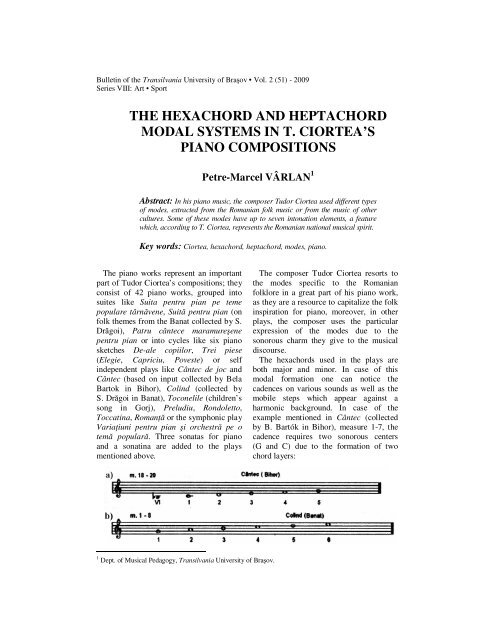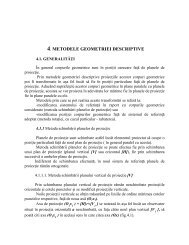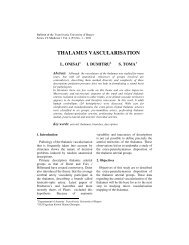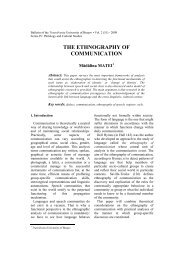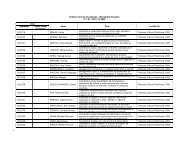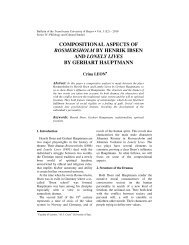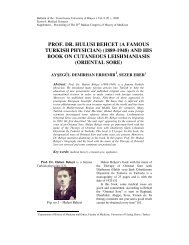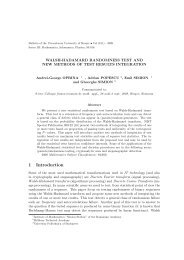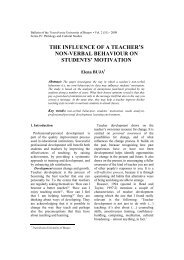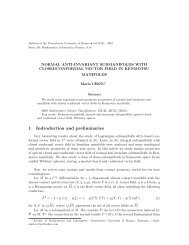the hexachord and heptachord modal systems in t. ciortea's piano ...
the hexachord and heptachord modal systems in t. ciortea's piano ...
the hexachord and heptachord modal systems in t. ciortea's piano ...
Create successful ePaper yourself
Turn your PDF publications into a flip-book with our unique Google optimized e-Paper software.
Bullet<strong>in</strong> of <strong>the</strong> Transilvania University of Braşov • Vol. 2 (51) - 2009<br />
Series VIII: Art • Sport<br />
THE HEXACHORD AND HEPTACHORD<br />
MODAL SYSTEMS IN T. CIORTEA’S<br />
PIANO COMPOSITIONS<br />
Petre-Marcel VÂRLAN 1<br />
Abstract: In his <strong>piano</strong> music, <strong>the</strong> composer Tudor Ciortea used different types<br />
of modes, extracted from <strong>the</strong> Romanian folk music or from <strong>the</strong> music of o<strong>the</strong>r<br />
cultures. Some of <strong>the</strong>se modes have up to seven <strong>in</strong>tonation elements, a feature<br />
which, accord<strong>in</strong>g to T. Ciortea, represents <strong>the</strong> Romanian national musical spirit.<br />
Key words: Ciortea, <strong>hexachord</strong>, <strong>heptachord</strong>, modes, <strong>piano</strong>.<br />
The <strong>piano</strong> works represent an important<br />
part of Tudor Ciortea’s compositions; <strong>the</strong>y<br />
consist of 42 <strong>piano</strong> works, grouped <strong>in</strong>to<br />
suites like Suita pentru pian pe teme<br />
populare târnăvene, Suită pentru pian (on<br />
folk <strong>the</strong>mes from <strong>the</strong> Banat collected by S.<br />
Drăgoi), Patru cântece maramureşene<br />
pentru pian or <strong>in</strong>to cycles like six <strong>piano</strong><br />
sketches De-ale copiilor, Trei piese<br />
(Elegie, Capriciu, Poveste) or self<br />
<strong>in</strong>dependent plays like Cântec de joc <strong>and</strong><br />
Cântec (based on <strong>in</strong>put collected by Bela<br />
Bartok <strong>in</strong> Bihor), Col<strong>in</strong>d (collected by<br />
S. Drăgoi <strong>in</strong> Banat), Toconelile (children’s<br />
song <strong>in</strong> Gorj), Preludiu, Rondoletto,<br />
Toccat<strong>in</strong>a, RomanŃă or <strong>the</strong> symphonic play<br />
VariaŃiuni pentru pian şi orchestră pe o<br />
temă populară. Three sonatas for <strong>piano</strong><br />
<strong>and</strong> a sonat<strong>in</strong>a are added to <strong>the</strong> plays<br />
mentioned above.<br />
The composer Tudor Ciortea resorts to<br />
<strong>the</strong> modes specific to <strong>the</strong> Romanian<br />
folklore <strong>in</strong> a great part of his <strong>piano</strong> work,<br />
as <strong>the</strong>y are a resource to capitalize <strong>the</strong> folk<br />
<strong>in</strong>spiration for <strong>piano</strong>, moreover, <strong>in</strong> o<strong>the</strong>r<br />
plays, <strong>the</strong> composer uses <strong>the</strong> particular<br />
expression of <strong>the</strong> modes due to <strong>the</strong><br />
sonorous charm <strong>the</strong>y give to <strong>the</strong> musical<br />
discourse.<br />
The <strong>hexachord</strong>s used <strong>in</strong> <strong>the</strong> plays are<br />
both major <strong>and</strong> m<strong>in</strong>or. In case of this<br />
<strong>modal</strong> formation one can notice <strong>the</strong><br />
cadences on various sounds as well as <strong>the</strong><br />
mobile steps which appear aga<strong>in</strong>st a<br />
harmonic background. In case of <strong>the</strong><br />
example mentioned <strong>in</strong> Cântec (collected<br />
by B. Bartók <strong>in</strong> Bihor), measure 1-7, <strong>the</strong><br />
cadence requires two sonorous centers<br />
(G <strong>and</strong> C) due to <strong>the</strong> formation of two<br />
chord layers:<br />
1 Dept. of Musical Pedagogy, Transilvania University of Braşov.
74<br />
Bullet<strong>in</strong> of <strong>the</strong> Transilvania University of Braşov • Vol. 2 (51) - 2009 • Series VIII<br />
E.g. 1<br />
The composer develops <strong>heptachord</strong><br />
formations [1] of <strong>the</strong> Dorian type with<br />
fixed <strong>and</strong> mobile steps (E.g. 2 – a: Cântec<br />
from Suita pe teme bănăŃene) <strong>and</strong> of <strong>the</strong><br />
Aeolian type (with <strong>the</strong> seventh step<br />
mobile) from <strong>hexachord</strong>s by <strong>the</strong><br />
appearance of a new sound <strong>in</strong> <strong>the</strong> harmonic<br />
background (E.g. 2 – b):<br />
E.g. 2<br />
The hexatonic scale is used <strong>in</strong> <strong>the</strong> <strong>piano</strong><br />
play Elegie (measures 6-14 from Trei piese<br />
pentru pian) <strong>in</strong> a structure of three harmonictonal<br />
layers – <strong>the</strong> hexatonic <strong>modal</strong> system<br />
with <strong>the</strong> double third (F, F #) / <strong>the</strong> hexatonic<br />
mode <strong>in</strong> transposition 1/m<strong>in</strong>or chord on E b:<br />
The hexatonic mode is also used <strong>in</strong> o<strong>the</strong>r<br />
works like Joc (Vo<strong>in</strong>iceşte) <strong>in</strong> Suita pe<br />
E.g. 3<br />
teme târnăvene or Rondoletto:
Vârlan, P.M.: The Hexachord- <strong>and</strong> Heptachord Modal System <strong>in</strong> T.Ciortea’s Piano…. 75<br />
E.g. 4<br />
In Bocet (Suita pe teme bănăŃene), this<br />
mode appears with a chang<strong>in</strong>g note which<br />
does not <strong>in</strong>terfere with its structural profile<br />
(<strong>the</strong> sound C appears only <strong>in</strong> measure 8 as<br />
a chang<strong>in</strong>g note):<br />
The follow<strong>in</strong>g examples will present <strong>the</strong><br />
<strong>heptachord</strong> modes used under varied types,<br />
diatonic, with fixed or mobile steps, like <strong>the</strong><br />
Ionian mode (a) <strong>the</strong> Ionian mode with<br />
acoustic 1 agreement (b), <strong>the</strong> Ionian mode<br />
with acoustic 2 agreement (c), <strong>the</strong> Ionian<br />
mode with acoustic 5 agreement (d) <strong>and</strong><br />
o<strong>the</strong>rs like <strong>the</strong> Dorian mode, <strong>the</strong> Dorian<br />
mode with Istrian agreement or <strong>the</strong><br />
chromatic mode [2] 1a agreement, <strong>the</strong><br />
E.g. 5<br />
Dorian mode with Aeolian agreement, <strong>the</strong><br />
Phrygian mode, <strong>the</strong> Lydian mode, <strong>the</strong><br />
Mixolydian mode, <strong>the</strong> Mixolydian mode<br />
with Doric agreement, <strong>the</strong> Aeolian mode,<br />
<strong>the</strong> Aeolian mode with acoustic agreements<br />
2, <strong>the</strong> Aeolian mode with Doric agreement,<br />
<strong>the</strong> Aeolian mode with Istrian agreement,<br />
<strong>the</strong> Locrian mode, acoustic mode 1,<br />
acoustic mode 2:
76<br />
Bullet<strong>in</strong> of <strong>the</strong> Transilvania University of Braşov • Vol. 2 (51) - 2009 • Series VIII<br />
E.g. 6<br />
In case d, mentioned above, (Cântec la clacă de tors), <strong>the</strong> mode consists of two<br />
tetrachord submodes, which <strong>in</strong> fact co<strong>in</strong>cide with <strong>the</strong> tetrachords of <strong>the</strong> <strong>heptachord</strong> mode<br />
(<strong>in</strong> E.g. 6: *it is sharp <strong>in</strong> <strong>the</strong> score; we consider it B flat because it shows <strong>the</strong> mobility of<br />
<strong>the</strong> <strong>modal</strong> third; **it appears only at <strong>the</strong> end as a Mixolydian characteristic).<br />
The composer also uses chromatic <strong>heptachord</strong> modes, out of which some also have<br />
mobile steps, like <strong>in</strong> <strong>the</strong> follow<strong>in</strong>g example – <strong>the</strong> chromatic 1a (a), structure b (b) <strong>and</strong><br />
structure d (c) or <strong>the</strong> agreements of <strong>the</strong> structures a <strong>and</strong> b (e):<br />
E.g. 7<br />
An octachord mode is also found, which<br />
is <strong>the</strong> result of <strong>the</strong> comb<strong>in</strong>ation of <strong>the</strong><br />
tetratonics of <strong>the</strong> melodic conduct – to be<br />
noticed <strong>in</strong> <strong>the</strong> example no. 2 – <strong>and</strong> <strong>the</strong><br />
harmonic background:<br />
E.g. 8<br />
The acoustic modes (E.g. 9) are well<br />
displayed by <strong>the</strong> uses with or without<br />
modified steps – acoustic 1 (a) <strong>and</strong><br />
acoustic 2, acoustic 1 with Doric<br />
agreement (b) <strong>and</strong> o<strong>the</strong>r modes with<br />
agreement – acoustic 1 with Lydian<br />
agreement, acoustic 1 with Mixolydian<br />
agreement – some of <strong>the</strong>m with a cadence<br />
on various steps:
Vârlan, P.M.: The Hexachord- <strong>and</strong> Heptachord Modal System <strong>in</strong> T.Ciortea’s Piano…. 77<br />
The acoustic 2 appears <strong>in</strong> <strong>the</strong> follow<strong>in</strong>g<br />
cases without agreements (a), with<br />
E.g. 9<br />
chromatic 2a agreement (b) or with Aeolic<br />
agreement:<br />
The acoustics 5 <strong>and</strong> 6 appear <strong>in</strong> <strong>the</strong> plays<br />
Joc (Pe loc <strong>and</strong> Călniceana) <strong>and</strong> Col<strong>in</strong>dă<br />
E. g. 10<br />
<strong>in</strong> Suita pe teme bănăŃene <strong>and</strong> <strong>in</strong> Piano<br />
Sonata no. 1:<br />
E.g. 11<br />
Mode 2 is also used, with limited <strong>and</strong> <strong>in</strong> first transposition – b) [3]:<br />
transposition (<strong>in</strong> second transposition – a,<br />
In Piano Sonata no. 1 <strong>the</strong> composer used<br />
<strong>the</strong> second <strong>and</strong> third transposition, while <strong>in</strong><br />
Piano Sonatas no. 2 <strong>and</strong> no. 3 he used <strong>the</strong><br />
first <strong>and</strong> <strong>the</strong> third transposition. This mode<br />
also has mobile steps (E.g. 13 - *mode 2<br />
E.g. 12<br />
with limited transposition <strong>in</strong> transposition<br />
3, with marked <strong>in</strong>consistencies which<br />
appear sporadically <strong>and</strong> create harmonic<br />
layers):<br />
E.g. 13
78<br />
Bullet<strong>in</strong> of <strong>the</strong> Transilvania University of Braşov • Vol. 2 (51) - 2009 • Series VIII<br />
In Preludiu, which reflects <strong>the</strong><br />
composer’s apprenticeship period, we can<br />
identify an application of <strong>the</strong> wheel<br />
pr<strong>in</strong>ciple (trohos) <strong>in</strong> <strong>the</strong> Byzant<strong>in</strong>e music,<br />
as a system of <strong>modal</strong> construction <strong>and</strong><br />
melody composition, based on chromatic<br />
tetrachords, by plac<strong>in</strong>g <strong>the</strong>ir <strong>modal</strong> centers<br />
on o<strong>the</strong>r pitches ra<strong>the</strong>r than on <strong>the</strong> <strong>in</strong>itial<br />
one. The connection among <strong>the</strong> respective<br />
centers is made by a common sound like<br />
<strong>the</strong> Greek s<strong>in</strong>aphé.<br />
The follow<strong>in</strong>g example shows <strong>the</strong><br />
application of <strong>the</strong> pr<strong>in</strong>ciple accord<strong>in</strong>g to<br />
<strong>the</strong> fourth wheel (tetrachord, 4 sound<br />
micro mode) aga<strong>in</strong>st <strong>the</strong> chromatic mode 6<br />
<strong>in</strong> <strong>the</strong> <strong>modal</strong> system of <strong>the</strong> Byzant<strong>in</strong>e<br />
music:<br />
E.g. 14<br />
The plays called Preludiu <strong>and</strong> Piano<br />
Sonata no. 1 (part I, measure 84) are plays<br />
<strong>in</strong> which <strong>the</strong> composer resorts to <strong>the</strong><br />
<strong>in</strong>verted chromatic formula, which is also<br />
an aspect of <strong>the</strong> mobility of steps, a<br />
resonance of <strong>the</strong> Byzant<strong>in</strong>e music, but<br />
especially of folklore. The follow<strong>in</strong>g<br />
example shows this case by a gravitational<br />
stratification C/ F [4]:<br />
E.g. 15<br />
References<br />
1. Giuleanu, V. Tratat de teoria muzicii.<br />
Bucureşti: Editura Muzicală, 1986.<br />
2. Oprea, Gh.; Agapie, L. Folclor<br />
muzical românesc. Bucureşti: Editura<br />
Didactică şi Pedagogică, 1983.<br />
3. Messiaen, O. Technique de mon<br />
langage musical. Paris: Edition<br />
Musicales, Leduc, 1944.<br />
4. Terényi, E. Armonia muzicii moderne<br />
(1900-1950). Cluj-Napoca: Editura<br />
MediaMusica, 2001.


